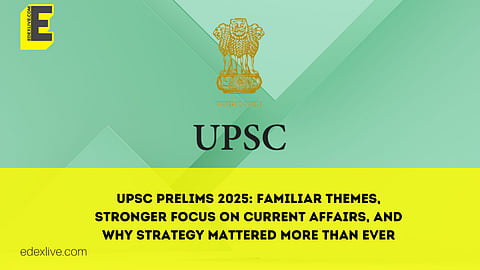UPSC Prelims 2025: Familiar themes, stronger focus on current affairs, and why strategy mattered more than ever
With the UPSC Civil Services Preliminary Examination (UPSC) 2025 now concluded, lakhs of aspirants are in the analysis phase, awaiting Civil Services Aptitude Test (CSAT) scores and cut-off predictions.
Early insights from Rohit Pande, Co-founder and CEO of CivilsDaily IAS, highlight how this year’s GS Paper 1 rewarded not just knowledge, but strategy, especially for those under the guidance of mentors who had closely tracked recent UPSC trends.
Here’s a breakdown of how the paper shaped up:
1. Past-year patterns dominated — Mentorship became a clear advantage
A striking feature of the 2025 Prelims was its resemblance to past year questions (PYQs) and known microthemes. From Araghatta and Isotherms to Head Budget and the Nativity of Papaya, the paper echoed UPSC’s older favorites.
Aspirants who had access to mentors, particularly recent toppers, benefited from their ability to spot patterns and emphasise high-return topics. Structured guidance helped many approach the paper with precision and clarity.
2. Geography was the toughest nut to crack
This year, Geography stood out as the most challenging section. Questions required not just textbook knowledge, but fine conceptual clarity, especially in world map-based items, such as identifying equatorial lakes. It served as a reminder that no section is truly “static” in UPSC anymore.
3. Current affairs reclaimed the spotlight
After being on the back burner in recent years, current affairs made a strong return. Topics like Brazil, Russia, India, China, and South Africa (BRICS), North Atlantic Treaty Organization (NATO), Asian Development Bank (ADB), Conference of the Parties (COP28), European Union (EU), and International North-South Transport Corridor (INSTC) featured prominently.
Candidates who ignored CA or relied only on static portions may have found themselves on shaky ground.
4. Easier than 2024, but strategy still made the difference
Overall, the paper was seen as less difficult than the 2024 version, but that didn’t automatically mean higher scores. With CSAT on the tougher side, the expected GS cut-off may stay in the 85–90 range. Students who approached the paper with insights from last year’s trends or expert mentoring had a noticeable edge.
5. Lengthy questions tested composure and time management
Several questions, especially from Polity and Geography, were dense and required significant time to read and decode. With four closely worded options per question, aspirants had to balance speed with accuracy, a skill often developed through mock test practice and mentor-led prep strategies.
6. Economics balanced CA with an unexpected quant surprise
Economy questions leaned toward current developments, but included two unexpected formula-based questions, on Gross Domestic Product (GDP) and Fiscal Deficit, which haven’t been common in recent years. Those with strong fundamentals and familiarity with core concepts could navigate these successfully.
7. Modern history was a scoring opportunity
In contrast to other sections, modern history emerged as the most accessible this year. Eight questions, including two each on Mahatma Gandhi and the Non-Cooperation Movement, made it a high-yield area for those who had consistently revised National Council of Educational Research and Training (NCERT) and standard texts.
8. Polity was predictable in theme, but demanded precision
Polity continued its trend of focusing on well-known constitutional areas such as Schedules and state-specific provisions, but the questions were anything but simple. Differentiating between subtle options required detailed preparation, not just casual familiarity.
Conclusion: Strategy > syllabus
This year’s Prelims highlighted a simple truth: knowing the syllabus isn’t enough. The candidates who performed well were those who had decoded the exam’s deeper patterns often with help from mentors and experienced peers.
With evolving paper trends, the difference between a good attempt and a great one may just lie in the kind of guidance an aspirant receives.



